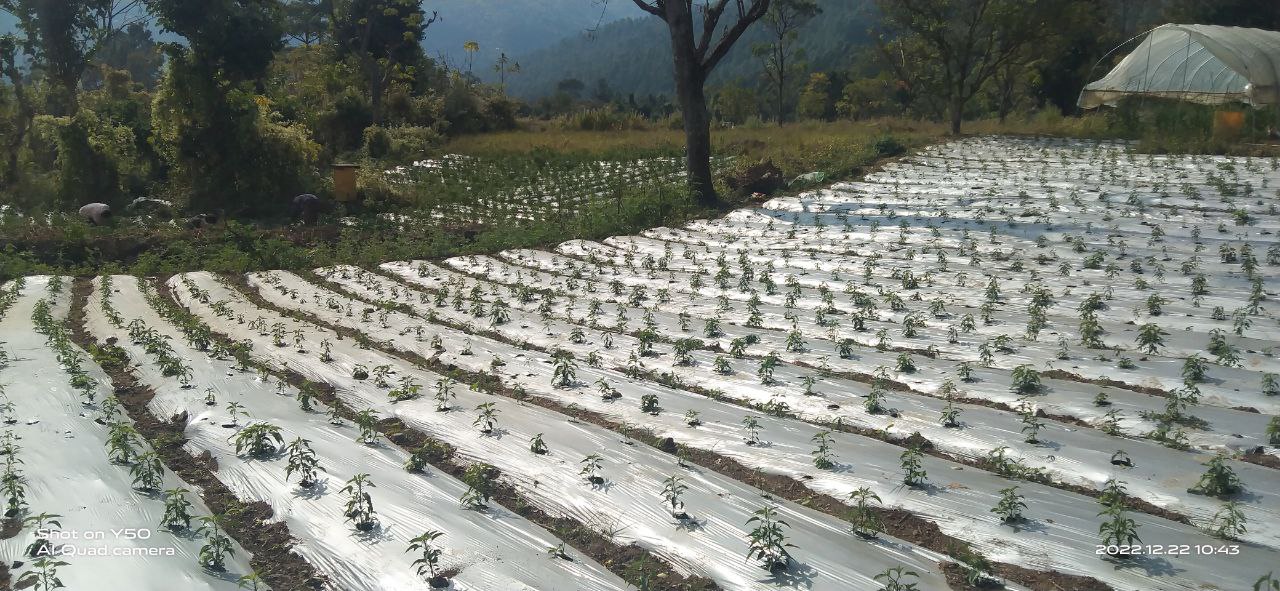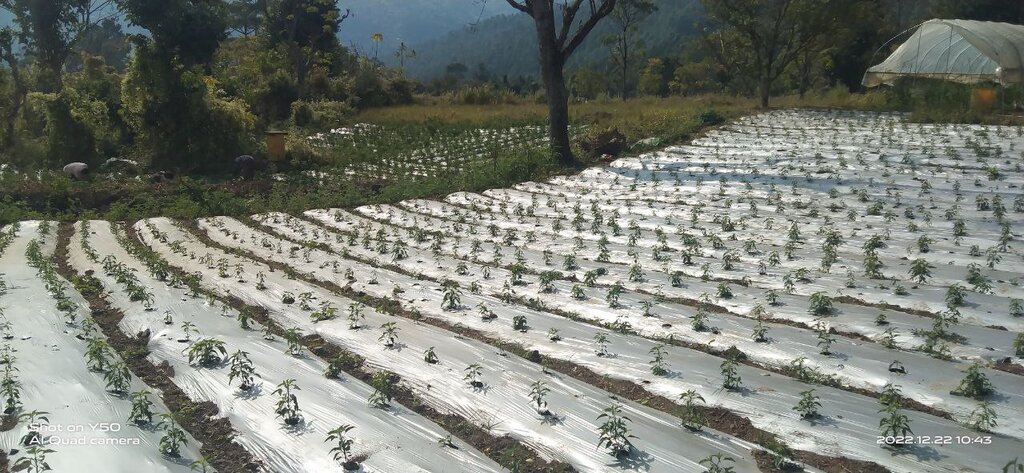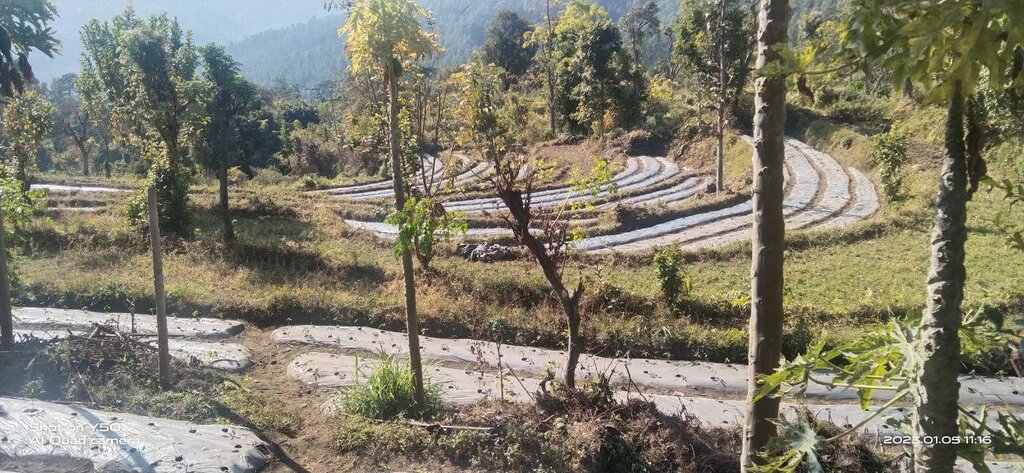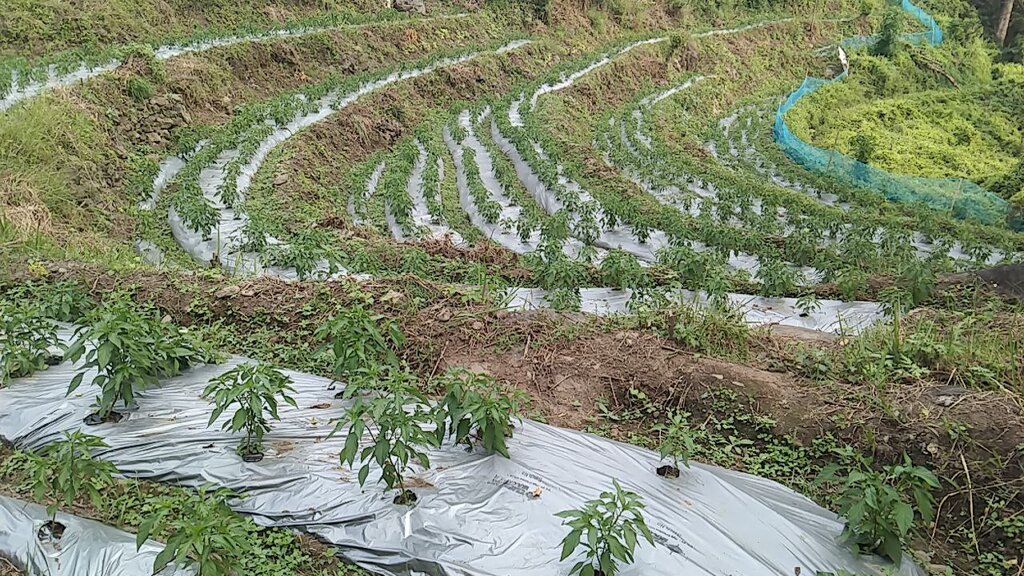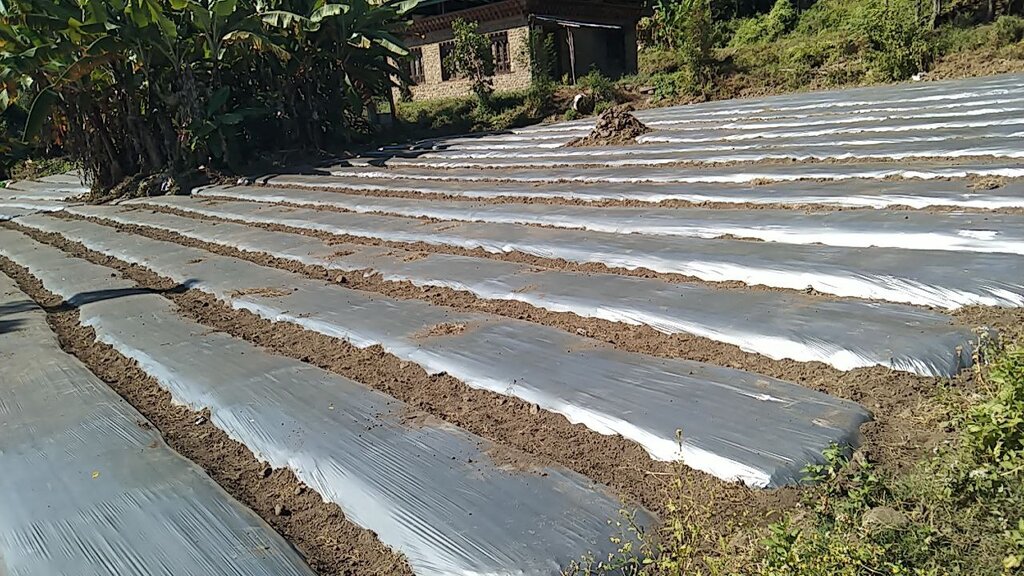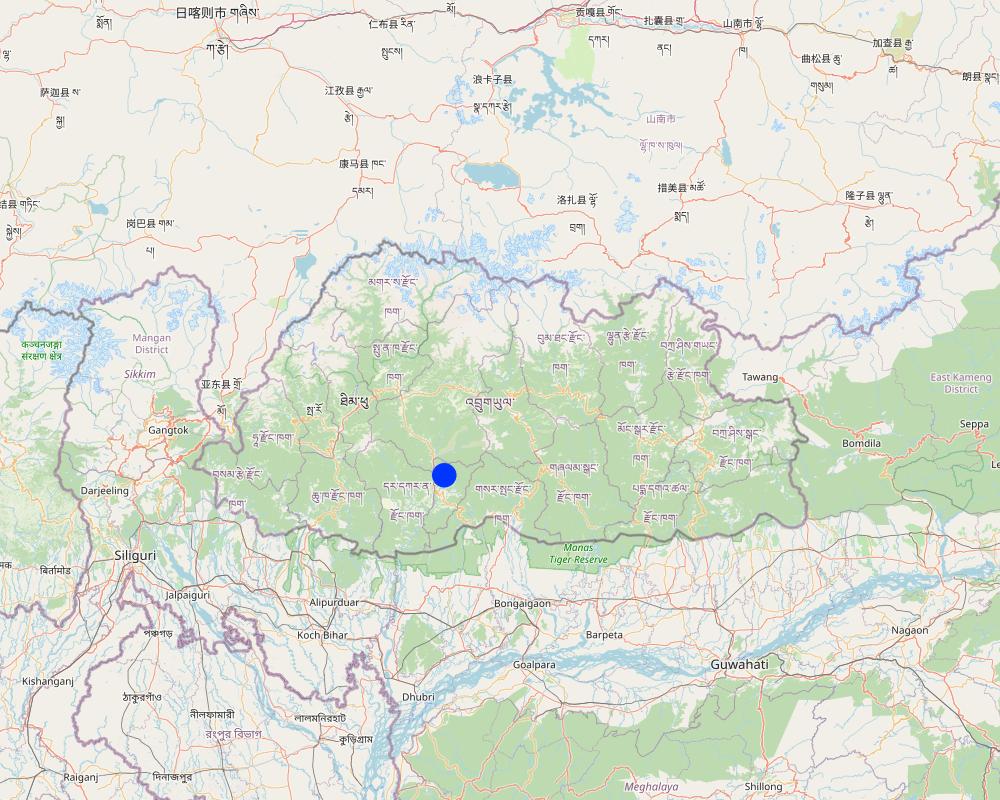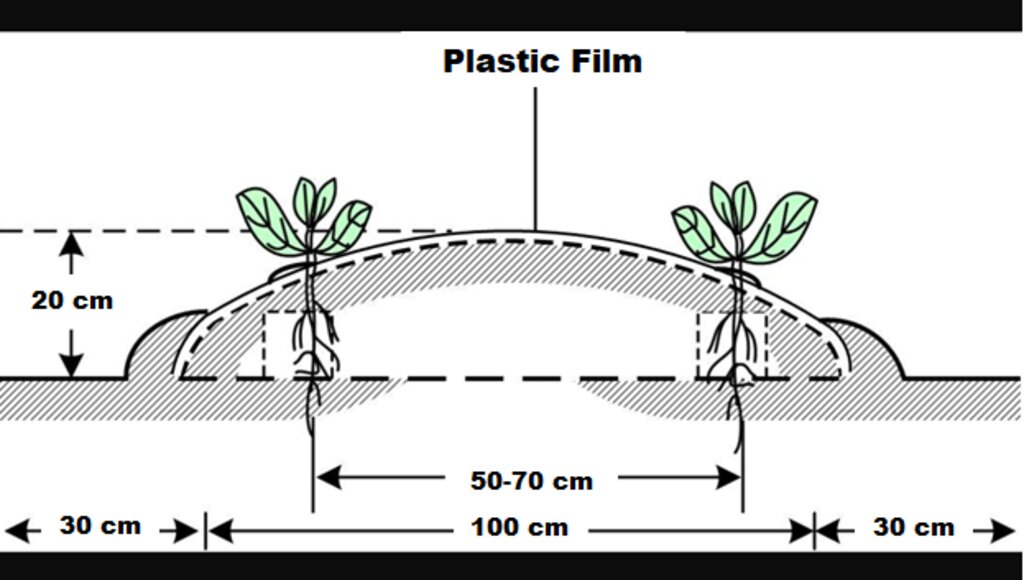Plastic mulching for cash crops [بوتان]
- تاريخ الإنشاء:
- تحديث:
- جامع المعلومات: Tshering Yangzom
- المحرر: Kuenzang Nima
- المراجعون: William Critchley, Rima Mekdaschi Studer, Joana Eichenberger
Nyuel Thok Nang Chhu Sho Thing Ni (དངུལ་ཐོག་ནང་ཆུ་ཤོག་ཐིང་ནི།)
technologies_6864 - بوتان
عرض الأقسام
توسيع الكل طي الكل1. معلومات عامة
1.2 تفاصيل الاتصال بالأشخاص الرئيسيين لمصدر المعلومات والمؤسسات المشاركة في تقييم وتوثيق التقنية
الشخص (الأشخاص) الرئيسي لمصدر المعلومات
مستخدم الأرض:
Rai Pratap Singh
بوتان
اسم المشروع الذي سهّل توثيق/تقييم التقنية (إذا كان ذلك على صلة)
Strengthening national-level institutional and professional capacities of country Parties towards enhanced UNCCD monitoring and reporting – GEF 7 EA Umbrella II (GEF 7 UNCCD Enabling Activities_Umbrella II)اسم المؤسسة (المؤسسات) التي سهلت توثيق/تقييم التقنية (إذا كان ذلك على صلة)
National Soil Services Center, Department of Agric (National Soil Services Center, Department of Agric) - بوتان1.3 الشروط المتعلقة باستخدام البيانات الموثقة من خلال WOCAT
يوافق جامع المعلومات والشخص (لاشخاص) الرئيسي لمصدر المعلومات على الشروط المتعلقة باستخدام البيانات الموثقة من خلال WOCAT:
نعم
1.4 إعلان بشأن استدامة التقنية الموصوفة
هل التقنية الموصوفة هنا تمثل مشكلة فيما يتعلق بتدهور الأراضي، بحيث لا يمكن إعلانها تقنية مستدامة لإدارة الأراضي؟:
كلا
التعليقات:
Mulching in agriculture helps conserve moisture, prevent water and wind erosion, control weeds, and regulate soil temperature. While it has these benefits, it also poses environmental concerns related to soil contamination and waste accumulation. Plastic mulches are a significant source of microplastic pollution in agricultural soils. The residual microplastics in the soil negatively affect soil health. Used plastic mulches are eventually burned and the burning releases greenhouse gases, contributing to climate change and global warming. Additionally, the residues left behind after burning plastic mulches can persist in the soil for extended periods thereby contaminating the soil. Though mulching helps increase crop yields, it has negative effects on the natural environment and thus the use of mulching necessitates careful consideration.
2. وصف تقنيةالإدارة المستدامي للأراضي
2.1 وصف مختصر للتقنية
تعريف التقنية:
Plastic mulching comprises thin plastic sheets laid out on raised soil surfaces around plants to help conserve soil moisture, prevent water and wind erosion, control weeds, and regulate soil temperature. It is used in agriculture to increase crop yields. However, there are environmental concerns about soil contamination and waste disposal.
2.2 وصف تفصيلي للتقنية
الوصف:
Plastic mulching is a widely used agricultural practice in Bhutan, primarily employed in the cultivation of cash crops. Farmers have adopted plastic mulching to enhance crop production and address specific agricultural challenges. It allows farmers to optimize water usage by reducing evaporation and maintaining soil moisture levels, which is crucial in regions where water resources are limited. It also helps suppress weed growth, minimizing competition for nutrients and ensuring healthier crop growth. Additionally, the regulation of soil temperature through plastic mulching can extend the growing season and improve crop quality and yields. These benefits are particularly valuable in Bhutan's mountainous terrain and varied climatic conditions.
However, the application of plastic mulching can have both direct and indirect impacts on the natural environment. Improper disposal or management of plastic mulch can lead to environmental pollution, including soil contamination and plastic waste accumulation. Therefore, sustainable practices and appropriate waste management techniques are crucial to minimize the potential negative effects on the natural environment.
Plastic mulching serves several purposes and functions in agricultural practices. One of its primary functions is moisture conservation, as it helps prevent water evaporation from the soil surface by acting as a barrier. Additionally, plastic mulch controls weeds by blocking sunlight and inhibiting weed seed germination, reducing competition for nutrients. Another important function is soil temperature regulation, as plastic mulching traps heat from the sun, raising soil temperatures in cooler climates and promoting faster plant growth. Overall, plastic mulch contributes to enhanced crop performance.
Furthermore, it helps prevent soil erosion by protecting the soil surface from wind and water erosion, thus maintaining soil structure and fertility, and creating a barrier between plants and the soil, reducing the risk of soil-borne pests and diseases affecting the crops. It can also deter certain pests by disrupting their habitat and limiting access to plants.
Plastic mulching involves the use of thin sheets or films made of polyethylene or similar materials, which come in various colours and thicknesses. Manual tools are utilized to lay the sheets evenly over the prepared soil. Before laying the plastic mulch, the soil is typically ploughed, levelled, raised, and cleared of debris to create a smooth surface. To prevent displacement by wind or other factors, the plastic mulch needs to be securely anchored to the ground. Plastic mulching can be combined with drip irrigation systems to provide water and nutrients directly to the plant roots.
Some specific advantages pointed out by the land user include the opportunity to achieve higher returns on agricultural investments. It reduces the need for manual weeding or herbicide application, saving time, labour, and resources. Additionally, it reduces the frequency of irrigation. It also extends the growing season expanding options and potential profits. There are many advantages of mulching but there are some serious disadvantages of the technology. Plastic mulching poses environmental concerns related to soil contamination and waste accumulation. Plastic mulches are a significant source of microplastic pollution in agricultural soils and these microplastics negatively affect soil health. The disposal of plastic mulches is a challenge as recycling options are limited resulting in waste accumulation on farms. These accumulated wastes are eventually burned and release greenhouse gases, contributing to climate change and global warming. Additionally, the residues left behind after burning plastic mulches can persist in the soil for extended periods thereby contaminating the soil. Also, the cost of purchasing plastic mulch can prove to be too high for farmers if the land area is huge. Though mulching helps increase crop yields, it has negative effects on the natural environment - thus the use of mulching necessitates careful consideration.
2.3 صور التقنية
2.5 البلد/المنطقة/المواقع التي تم تنفيذ التقنية فيها والتي يغطيها هذا التقييم
البلد:
بوتان
المنطقة/الولاية/المحافظة:
Sergithang, Tsirang
حدد انتشار التقنية:
- منتشرة بالتساوي على مساحة
إذا كانت المساحة الدقيقة غير معروفة، فيرجى الإشارة إلى المنطقة التقريبية المغطاة:
- < 0.1 كم2 (10 هكتار)
هل يقع موقع/مواقع التقنية في منطقة محمية بشكل دائم؟:
كلا
التعليقات:
The land user uses plastic mulching on 1 acre of land for chili production.
Map
×2.6 تاريخ التنفيذ
اذكر سنة التنفيذ:
2018
2.7 إدخال التقنية
- It was introduced by the gewog Agriculture Extension Officer and through exposure to social media.
3. تصنيف تقنية الإدارة المستدامي للأراضي
3.1 الغرض الرئيسي ( الأغراض الرئيسية) للتقنية
- تحسين الإنتاج
- خلق أثر اقتصادي مفيد
3.2 نوع (أنواع) استخدام الأراضي الحالية حيث يتم تطبيق التقنية
استخدامات الأراضي مختلطة ضمن نفس وحدة الأرض:
نعم
حدد استخدام الأراضي المختلطة (المحاصيل / الرعي / الأشجار):
- الحراجة الزراعية

الأراضي الزراعية
- زراعة سنوية
- زراعة الأشجار والشجيرات
الزراعة السنوية - حدد المحاصيل:
- الحبوب - الذرة
- الحبوب - الأرز (الأراضي الرطبة)
- المحاصيل الجذرية/الدرنية - البطاطس
- الخضروات - الخضروات الورقية (السلطات، الملفوف، السبانخ، وغيرها)
- الخضروات - البطيخ، اليقطين، الكوسى أو القريع
- الخضروات - الخضروات الجذرية (الجزر والبصل والشمندر وغيرها)
زراعة الأشجار والشجيرات -حدد المحاصيل:
- الافوكادو
- فواكه أخرى
- المانجو، المانغوستين، الجوافة
عدد مواسم الزراعة في السنة:
- 2
هل يتم ممارسة الزراعة البينية؟:
نعم
إذا كانت الإجابة بنعم، حدد المحاصيل التي يتم زراعتها بشكل بيني:
Vegetable crops are intercropped for self-consumption.
هل تتم ممارسة تناوب المحاصيل؟:
نعم
إذا كانت الإجابة بنعم، حدد:
Vegetable crops are rotated.

الغابات/ الأراضي الحرجية
- الغابات/الأراضي الحرجية (شبه) الطبيعية
هل الأشجار المذكورة أعلاه ملحاء أم دائمة الخضرة؟:
- مختلطة ملحاء / دائمة الخضرة
منتجات وخدمات:
- حطب الوقود
3.3 هل تغير استخدام الأراضي نتيجة لتنفيذ التقنية؟
هل تغير استخدام الأراضي نتيجة لتنفيذ التقنية؟:
- لا (تابع مع السؤال 3.4)
3.4 إمدادات المياه
إمدادات المياه للأرض التي يتم تنفيذ التقنية عليها:
- مختلط بعلي-مروي
التعليقات:
The land users of Sergithang face water shortage problems.
3.5 مجموعةالإدارة المستدامة للأراضي التي تنتمي إليها هذه التقنية
- Weed management
3.6 التدابير التقنية في مجال إلادارة المستدامة للأراضي

تدابير أخرى
حدد:
Plastic mulching may fall under structural measures.
3.7 الأنواع الرئيسية من تدهور الأراضي التي تناولتها التقنية

تآكل التربة بالمياه
- الوزن(Wt): فقدان التربة السطحية/تآكل السطح

تآكل التربة الناتج عن الرياح
- (Et): فقدان التربة السطحية

التدهور البيولوجي
- (Bp): زيادة الآفات/الأمراض، وفقدان الحيوانات المفترسة

تدهور المياه
- (Ha): التجفيف
- (Hs): التغيير في كمية المياه السطحية
3.8 منع أو حد أو عكس تدهور الأراضي
تحديد هدف التقنية فيما يتعلق بتدهور الأراضي:
- منع تدهور الأراضي
- الحد من تدهور الأراضي
التعليقات:
Plastic mulching prevents soil and water erosion and conserves soil mositure.
4. المواصفات الفنية، وأنشطة التنفيذ، والمدخلات، والتكاليف
4.1 الرسم الفني للتقنية
المواصفات الفنية (المتعلقة بالرسم الفني):
This diagram shows a cross-section of a raised bed using plastic mulching. The plants grow through the punctured holes in the plastic. The length of the bed varies from farm to farm and is 1 m wide and spaced 30 cm apart (bed-bed spacing) for easy access/movement. The bed is usually raised to 20 cm in height. The planting distance shown in the diagram is for chilies, 50-70 cm. The distances will vary according to the crop/variety.
المؤلف:
Thinley Penjor Dorji
التاريخ:
20/07/2023
4.2 معلومات عامة بخصوص حساب المدخلات والتكاليف
حدد كيفية احتساب التكاليف والمدخلات:
- حسب مساحة تنفيذ التقنية
الإشارة إلى حجم ووحدة المساحة:
1 acre
عملة أخرى/ عملة وطنية (حدد):
Ngultrum
إذا كان ذا صلة، وضح سعر الصرف من الدولار الأمريكي إلى العملة المحلية (على سبيل المثال، 1 دولار أمريكي = 79.9 ريال برازيلي): 1 دولار أمريكي =:
82,1
اذكر متوسط تكلفة أجر العمالة المستأجرة في اليوم الواحد:
Nu 400
4.3 أنشطة التأسيس
| النشاط | التوقيت (الموسم) | |
|---|---|---|
| 1. | Field preparation (tilling) | Winter |
| 2. | Field preparation (rotary tilling) | Winter |
| 3. | Manure application | Winter |
| 4. | Bed preparation | Winter |
| 5. | Laying of plastic mulch | Winter |
| 6. | Making holes in the plastic | Winter |
| 7. | Transplantation | Winter |
4.4 التكاليف والمدخلات اللازمة للتأسيس
| تحديد المدخلات | الوحدة | الكمية | التكاليف لكل وحدة | إجمالي التكاليف لكل مدخل | % من التكاليف التي يتحملها مستخدمو الأراضي | |
|---|---|---|---|---|---|---|
| العمالة | Field preparation (tilling) | Person/day | 5,0 | 400,0 | 2000,0 | 100,0 |
| العمالة | Manure application and rotary tilling | Person/day | 8,0 | 400,0 | 3200,0 | 100,0 |
| العمالة | Bed preparation, laying of plastic mulch and making holes | Person/day | 12,0 | 400,0 | 4800,0 | 100,0 |
| العمالة | Transplantation | Person/day | 8,0 | 400,0 | 3200,0 | 100,0 |
| معدات | Power tiller (tilling) | Per day | 1,0 | 2500,0 | 2500,0 | 100,0 |
| معدات | Power tiller (rotary tilling) | Per day | 1,0 | 2500,0 | 2500,0 | 100,0 |
| المواد النباتية | Seeds | Packet | 5,0 | 15,0 | 75,0 | 100,0 |
| مواد البناء | Plastic mulch | Rolls | 4,0 | 2800,0 | 11200,0 | 100,0 |
| غير ذلك | Food and Refreshment | per person | 33,0 | 350,0 | 11550,0 | 100,0 |
| إجمالي تكاليف إنشاء التقنية | 41025,0 | |||||
| إجمالي تكاليف إنشاء التقنية بالدولار الأمريكي | 499,7 | |||||
4.5 الصيانة/الأنشطة المتكررة
التعليقات:
No maintenance work has been carried out.
4.6 التكاليف والمدخلات اللازمة للصيانة/للأنشطة المتكررة (سنويًا)
إذا لم تتمكن من تفصيل التكاليف في الجدول أعلاه، قدم تقديرًا للتكاليف الإجمالية لصيانة التقنية:
29823,0
التعليقات:
The plastic mulch is reused and hence there is no expenditure on the plastic mulches.
4.7 أهم العوامل المؤثرة على التكاليف
قدم وصفا لأهم العوامل التي تؤثر على التكاليف:
Higher cost of plastic mulching and hiring a power tiller.
5. البيئة الطبيعية والبشرية
5.1 المناخ
هطول الأمطار السنوي
- < 250 مم
- 251- 500 ملم
- 501 - 750ملم
- 1,000-751 ملم
- 1,500-1,100 ملم
- 2,000-1,500 ملم
- 3,000-2,001 ملم
- 4,000-3,100 ملم
- > 4000 ملم
المواصفات/التعليقات على هطول الأمطار:
Falls under Humid Sub-tropical Zone with an annual rainfall of 1200-2500 mm
الإشارة إلى اسم محطة الأرصاد الجوية المرجعية المعنية:
The rain estimate has been derived based on the agro-ecological zone (AEZ) the area falls under. Bhutan is divided into AEZs (source: https://www.fao.org/3/ad103e/AD103E02.htm).
المنطقة المناخية الزراعية
- رطبة
Bhutan has six AEZs. The wet sub-tropical zone is from 150 to 600 m, followed by the humid sub-tropical zone from 600 to 1,200 m. The dry sub-tropical zone starts at 1,200 m and extends to 1,800 m, followed by the warm temperate zone, which reaches 2,600 m. The cool temperate zone lies between 2,600 and 3,600 m and, finally, the alpine zone between 3,600 m and 4,600 m.
5.2 طوبوغرافيا
متوسط الانحدارات:
- مسطح (0-2%)
- بسيط (3-5%)
- معتدل (6-10%)
- متدحرج (11-15%)
- تلال (16-30%)
- شديدة الانحدار(31-60%)
- فائقة الانحدار (>60%)
التضاريس:
- هضاب/سهول
- أثلام مرتفعة
- المنحدرات الجبلية
- منحدرات التلال
- منحدرات في السفوح
- قاع الوادي
المنطقة الارتفاعية:
- 100-0 متر فوق سطح البحر
- 500-101 متر فوق سطح البحر
- 1,000-501 متر فوق سطح البحر
- 1,500-1,001 متر فوق سطح البحر
- 2,000-1,501 متر فوق سطح البحر
- 2,500-2,100 متر فوق سطح البحر
- 3,000-2,501 متر فوق سطح البحر
- 4,000-3,001 متر فوق سطح البحر
- > 4000 متر فوق سطح البحر
وضح ما إذا كانت التقنية مطبقة على وجه التحديد في:
- غير ذات صلة
5.3 التربة
متوسط عمق التربة:
- ضحل جدًا (0-20 سم)
- ضحلة (21-50 سم)
- متوسطة العمق (51-80 سم)
- عميقة (81-120 سم)
- عميقة جدًا (> 120 سم)
قوام التربة (التربة السطحية):
- متوسط ( طميي، سلتي)
قوام التربة (> 20 سم تحت السطح):
- متوسط ( طميي، سلتي)
المواد العضوية في التربة السطحية:
- عالية (>3%)
إذا كان متاحًا، قم بإرفاق وصف كامل للتربة أو تحديد المعلومات المتوفرة، على سبيل المثال نوع التربة، الرقم الهيدروجيني/ درجة حموضة التربة، قدرة التبادل الكاتيوني، النيتروجين، الملوحة وما إلى ذلك.
Moisture content-4.46%
Organic matter-5.85 %
Organic carbon-3.40%
pH-6.15
Electrical conductivity-853.00 µs/cm
Nitrogen-0.17
Phosphorus-1.92
Potassium-198.73 mg/100ml
Soil texture-Silt Clay Loam
5.4 توافر المياه ونوعيتها
منسوب المياه الجوفية:
50-5 م
توافر المياه السطحية:
متوسط
نوعية المياه (غير المعالجة):
مياه شرب جيدة
تشير جودة المياه إلى:
المياه السطحية
هل تعتبر ملوحة الماء مشكلة؟:
كلا
هل تحدث فيضانات في المنطقة؟:
كلا
5.5 التنوع البيولوجي
تنوع الأنواع:
- متوسط
تنوع الموائل:
- متوسط
5.6 خصائص مستخدمي الأراضي الذين يطبقون التقنية
مستقر أو مرتحل:
- غير المترحل
التوجه السوقي لنظام الإنتاج:
- مختلط (كفاف/ تجاري)
الدخل من خارج المزرعة:
- أقل من % 10من كامل الدخل
المستوى النسبي للثروة:
- متوسط
أفراداً أو مجموعات:
- فرد/أسرة معيشية
مستوى المكننة:
- عمل يدوي
- ميكانيكية/ مزودة بمحرك
الجنس:
- رجال
عمر مستخدمي الأرضي:
- متوسط العمر
5.7 متوسط مساحة الأرض التي يستخدمها مستخدمو الأراضي الذين يطبقون التقنية
- < 0.5 هكتارا
- 0.5 - 1 هكتار
- 1 -2 هكتار
- 2 - 5 هكتار
- 5 - 15 هكتار
- 15 - 50 هكتار
- 50 - 100هكتار
- 500-100 هكتار
- 1,000-500 هكتار
- 10,000-1,000 هكتار
- > 10,000 هكتار
هل يعتبر هذا نطاقًا صغيرًا أو متوسطًا أو واسعا (في إشارة إلى السياق المحلي)؟:
- على نطاق صغير
التعليقات:
1 acre or 0.404 ha
5.8 ملكية الأراضي، وحقوق استخدام الأراضي، وحقوق استخدام المياه
ملكية الارض:
- فردية، يوجد سند ملكية
حقوق استخدام الأراضي:
- فردي
حقوق استخدام المياه:
- مجتمعي (منظم)
هل تعتمد حقوق استخدام الأراضي على نظام قانوني تقليدي؟:
نعم
حدد:
The land use rights in Bhutan are based on a traditional legal system guided by formal land-act rules and regulations.
5.9 الوصول إلى الخدمات والبنية التحتية
الصحة:
- ضعيف
- معتدل
- جيد
التعليم:
- ضعيف
- معتدل
- جيد
المساعدة التقنية:
- ضعيف
- معتدل
- جيد
العمل (على سبيل المثال خارج المزرعة):
- ضعيف
- معتدل
- جيد
الأسواق:
- ضعيف
- معتدل
- جيد
الطاقة:
- ضعيف
- معتدل
- جيد
الطرق والنقل:
- ضعيف
- معتدل
- جيد
مياه الشرب وخدمات الصرف الصحي:
- ضعيف
- معتدل
- جيد
الخدمات المالية:
- ضعيف
- معتدل
- جيد
6. الآثار والتصريحات الختامية
6.1 الآثار التي أظهرتها التقنية في الموقع
الآثار الاجتماعية والاقتصادية
الإنتاج
إنتاج المحاصيل
التعليقات/ حدد:
The production of winter chili has increased to 700-800 kg following the use of mulching.
جودة المحاصيل
التعليقات/ حدد:
Crop quality has increased due to reduced competition from weeds.
خطر فشل الإنتاج
التعليقات/ حدد:
The risk has decreased as mulching helps conserve moisture, prevent water and wind erosion, control weeds, and regulate soil temperature.
إدارة الأراضي
التعليقات/ حدد:
Mulching reduces soil erosion.
الدخل والتكاليف
دخل المزرعة
التعليقات/ حدد:
The farm income from chilli has increased resulting from mulching
عبء العمل
التعليقات/ حدد:
Workload has decreased due to a reduction in weeding requirements.
الآثار الاجتماعية والثقافية
الأمن الغذائي / الاكتفاء الذاتي
التعليقات/ حدد:
The land user produces enough for self-consumption as well as for commercial purposes.
الآثار الايكولوجية
التربة
رطوبة التربة
التعليقات/ حدد:
Soil moisture is retained and the need for frequent irrigation is reduced.
فقدان التربة
التعليقات/ حدد:
Soil erosion has reduced due to mulching.
حدد تقييم الآثار في الموقع (القياسات):
These are the on-site impacts that have been shared by the land user. The land user has reused the mulches. He is unaware of the soil contamination caused by the plastics due to residual microplastics in the soil but is well aware of the wastes that will be generated. For the lack of better waste disposal options, like many other land users of the community the land user will opt to burn the wastes.
6.3 تعرض التقنية وحساسيتها لتغير المناخ التدريجي والظواهر المتطرفة/الكوارث المرتبطة بالمناخ (كما يراها مستخدمو الأراضي)
تغير مناخ تدريجي
تغير مناخ تدريجي
| الموسم | زيادة أو نقصان | كيف تتعامل التقنية مع ذلك؟ | |
|---|---|---|---|
| درجة الحرارة السنوية | زيادة | جيدا | |
| درجة الحرارة الموسمية | الشتاء | زيادة | جيدا |
| هطول الأمطار السنوي | زيادة | جيدا | |
| هطول الأمطار الموسمية | الصيف | زيادة | جيدا |
6.4 تحليل التكلفة والعائد
كيف يمكن مقارنة العوائد نسبة لتكاليف الإنشاء (من وجهة نظر مستخدمي الأراضي)؟
عوائد قصيرة الأجل:
إيجابي
عوائد طويلة الأجل:
إيجابي قليلا
كيف تتم مقارنة العوائدمع كلفة الصيانة/التكاليف المتكررة (من وجهة نظر مستخدمي الأراضي)؟
عوائد قصيرة الأجل:
إيجابي
عوائد طويلة الأجل:
سلبي قليلا
التعليقات:
In the long run, the benefits will be negative, as the land user has to invest in additional costly plastic mulch. Furthermore, the existing mulching plastic is not durable.
6.5 اعتماد التقنية
- > 50%
إذا كان متاحًا، قم بتحديد الكمية (عدد الأسر المعيشية و/أو المساحةالمغطاة):
All the land users of Sergithang have implemented the technology.
من بين جميع الذين تبنوا التقنية، كم عدد الذين فعلوا ذلك بشكل تلقائي، أي دون تلقي أي حوافز مادية/مدفوعات؟:
- 91-100%
6.6 التكيف
هل تم تعديل التقنية مؤخرًا لتتكيف مع الظروف المتغيرة؟:
كلا
6.7 نقاط القوة / المزايا / الفرص التي توفرها التقنية
| نقاط القوة/ المزايا/ الفرص من وجهة نظر مستخدمي الأراضي |
|---|
| Plastic mulching technology increases crop production. |
| The workload is reduced as there is reduction in the need of weeding. |
| It isn't a very complex technology and can be adopted easily. |
| Controls weeds. |
| نقاط القوة/ المزايا/ الفرص من وجهة نظر جامع المعلومات أو غيره من الاشخاص الرئيسيين لمصدر المعلومات |
|---|
| It aids off-season (winter) crop production. |
| Conserves moisture. |
| Reduces erosion (wind and water). |
6.8 نقاط ضعف / مساوىء / مخاطر التقنية وسبل التغلب عليها
| نقاط الضعف/ المساوىء/ المخاطر من وجهة نظر مستخدم الأراضي | كيف يمكن التغلب عليها؟ |
|---|---|
| Plastic mulching poses environmental concerns related to soil contamination and waste accumulation. | Disposal of plastic mulch is a challenge as recycling options are limited resulting in waste accumulation on farms. But one thing that the land users can do is switch to biodegradable plastic mulches or even better organic mulches (straw and Artemisia myriantha). In Bhutan straw and Artemisia myriantha mulches are very common. |
| Plastic mulching can prove to be very expensive if the land area is huge. | Opt for other more environmentally friendly alternatives such as straw and Artemisia myriantha mulching. |
7. المراجع والروابط
7.1 طرق جمع/مصادر المعلومات
- زيارات ميدانية، مسوحات ميدانية
1
- مقابلات مع مستخدمي الأراضي
1
متى تم تجميع البيانات (ميدانيا)؟:
19/07/2023
7.3 روابط للمعلومات ذات الصلة على الإنترنت
العنوان/الوصف:
Vegetable cultivation Theme 3 Mulching
عنوان الرابط URL:
http://rcbajo.gov.bt/wp-content/uploads/2020/05/Veg-Theme-03-Mulching-printing.pdf
الروابط والوحدات المواضيعية
توسيع الكل طي الكلالروابط
لا يوجد روابط
الوحدات المواضيعية
لا يوجد وحدات مواضيعية


